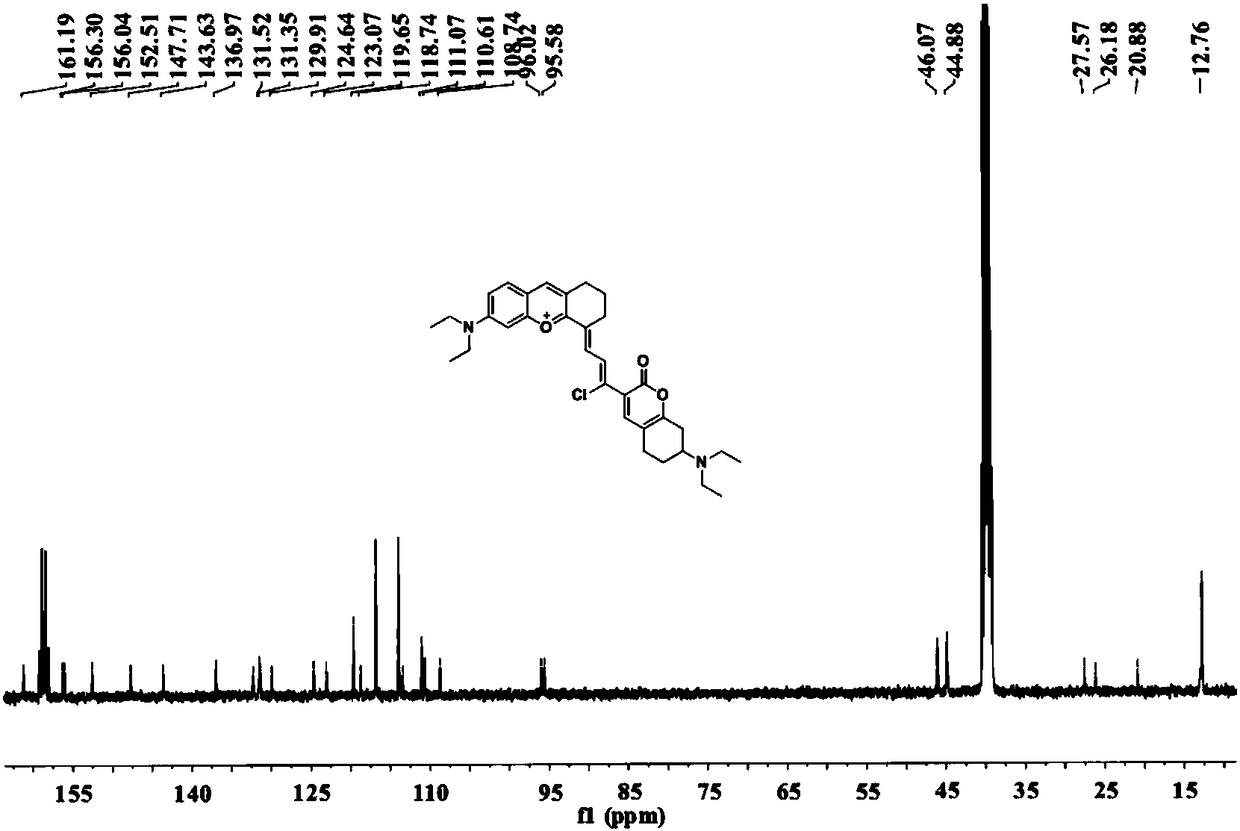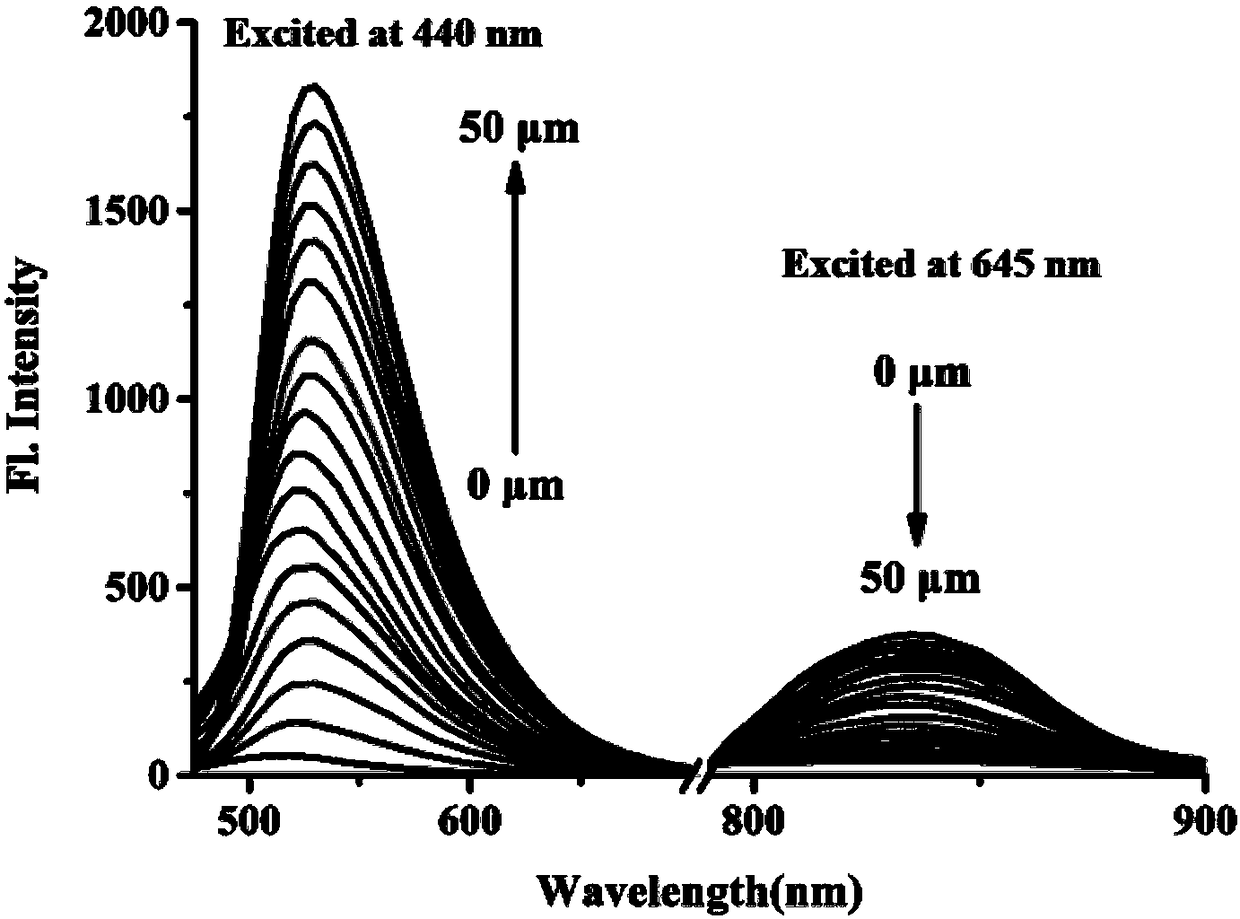Synthesis and application of near-infrared two-photon conversion type SO2 fluorescent probe
A fluorescent probe and two-photon technology, which is applied in the field of organic small molecule fluorescent probes, can solve the problems of environment and concentration effects, and achieve the effect of fast recognition speed and good specificity
- Summary
- Abstract
- Description
- Claims
- Application Information
AI Technical Summary
Problems solved by technology
Method used
Image
Examples
Embodiment 1
[0045] Example 1 Synthesis of Fluorescent Probes
[0046] (1) Synthesis of compound 1
[0047] ;
[0048] In a 100 mL round bottom flask, add 4-diethylamino salicylaldehyde (1.93 g, 10 mmol) and cyclohexanone (1.20 g, 12 mmol) and mix, add 10 mL of concentrated sulfuric acid to it and heat at reflux at 90°C and stir After 5 h, cool to room temperature, place the reaction system at -5 °C, add an appropriate amount of perchloric acid dropwise and add 200 mL of water, a large amount of solid precipitates, filter under reduced pressure, wash the filter cake with ethanol 2-3 times, and dry in vacuo , to obtain compound 1. The crude product was recrystallized from ethanol to obtain pure product. Yield: 87%;
[0049] (2) Synthesis of compound 2
[0050] ;
[0051] In a 100 mL round bottom flask, add 30 mL of ethanol, 4-diethylamino salicylaldehyde (1.93 g, 10 mmol), ethyl acetoacetate (1.30 g, 10 mmol), and a small amount of piperidine ( 150 μL), heated to 85°C and refluxe...
Embodiment 2
[0058] Example 2 Fluorescence probes detect the fluorescence intensity of different concentrations of sodium bisulfite
[0059] The dimethyl sulfoxide mother solution of the fluorescent probe obtained in Example 1 with a concentration of 1 mM was prepared for use.
[0060] The final concentration of the probe was 10 μM, PBS solution (pH 7.4) containing 20% acetonitrile solution was mixed with different concentrations of sodium bisulfite (1 μM, 2 μM, 3 μM, 4 μM, 5 μM, 6 μM, 7 μM, 8 μM, 9 μM, 10μM, 15μM, 20μM, 25μM, 30μM, 35μM, 40μM, 45μM, 50μM) are fully effective for fluorescence detection (λ ex =440 nm, λ em =530nm;λ ex =645 nm, λ em =835nm). The fluorescence intensity in each system was obtained, and the standard curve of fluorescence intensity and sodium bisulfite concentration was established, and the results were as follows: image 3 shown. Depend on image 3 It can be seen that as the concentration of sodium bisulfite increases, the fluorescence intensity at 530...
Embodiment 3
[0061] Example 3 Kinetic Test of Fluorescent Probe Recognition of Sulfur Dioxide
[0062] A dimethyl sulfoxide test mother solution of the fluorescent probe compound 4 obtained in Example 1 was prepared at a concentration of 1 mM for use.
[0063] Prepare the probe with a final concentration of 10 μM, PBS solution (pH 7.4) containing 20% acetonitrile solution, fully react with sodium bisulfite (50 μM), and perform fluorescence detection every 3s (λ ex =440 nm, λ em =530nm;λ ex =645 nm, λ em =835 nm). The fluorescence intensity in each system was obtained, and the standard curve of fluorescence intensity and time was established, such as Figure 4 shown. Depend on Figure 4 It can be seen that with the increase of time, the fluorescence intensity at 530 nm gradually increases, and the fluorescence intensity at 835 nm gradually decreases, and the reaction reaches equilibrium within 12 s, indicating that the probe can quickly recognize sulfur dioxide.
PUM
 Login to View More
Login to View More Abstract
Description
Claims
Application Information
 Login to View More
Login to View More - R&D
- Intellectual Property
- Life Sciences
- Materials
- Tech Scout
- Unparalleled Data Quality
- Higher Quality Content
- 60% Fewer Hallucinations
Browse by: Latest US Patents, China's latest patents, Technical Efficacy Thesaurus, Application Domain, Technology Topic, Popular Technical Reports.
© 2025 PatSnap. All rights reserved.Legal|Privacy policy|Modern Slavery Act Transparency Statement|Sitemap|About US| Contact US: help@patsnap.com



